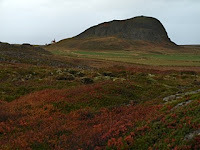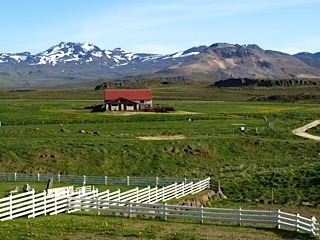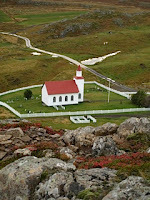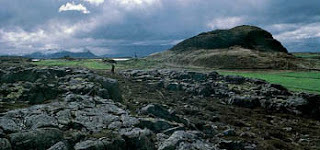A Thin Place in Iceland
 “For me Iceland is holy earth. This memory is background for everything I do. Iceland is the sun which colours the mountains without being there and gone over the horizon.”
“For me Iceland is holy earth. This memory is background for everything I do. Iceland is the sun which colours the mountains without being there and gone over the horizon.”In 1937, the American poets W.H. Auden and Louis MacNeice went to Iceland. They wrote about it in Letters from Iceland, a collection of poems, prose, photographs, charts, graphs, you name it. Auden also took time to chat with Matthias Johannessen and provided the Icelandic poet and newspaper editor with those three sentences, sentences that have echoed in my head ever since I read them in the magazine Iceland Review in 1987, the year after my first visit to Iceland.
In a March 2012 essay in the Sunday New York Times that I clipped out and saved, writer Eric Weiner evokes “thin places”—“places that beguile and inspire, sedate and stir, places where, for a few blissful moments I loosen my death grip on life, and can breathe again…. They are locales where the distance between heaven and earth collapses and we’re able to catch glimpses of the divine, or the transcendent or, as I like to think of it, the Infinite Whatever.”
It's obviously a hard topic to put into words, but I think I know what Weiner is getting at. He traces the phrase “thin places” to Celtic Christianity. George Macleod, the founder of the Iona Community on the Scottish island of that name, is generally credited with bringing the concept into modern times—to the extent that you can now take “thin places tours” to catch glimpses of a divine that is decidedly Christian. (See the blog “Thin Places” at www.thinplace.net.)
 I’m more interested in “the Infinite Whatever.” I catch glimpses of it regularly in Iceland, most often beside the hill named Helgafell, or Holy Mountain, by the first settler on the peninsula. According to the medieval Icelandic Eyrbyggja Saga, “Thorolf gave the name Thor’s Ness to the region between Vigra Fjord and Hofsvag. On this headland there is a mountain held so sacred by Thorolf that no-one was allowed even to look at it without first having washed himself, and no living creatures on this mountain, neither man or beasts, were to be harmed unless they left it of their own accord. Thorolf called that mountain Helga Fell and believed that he and his kinsmen would go into it when they died.”
I’m more interested in “the Infinite Whatever.” I catch glimpses of it regularly in Iceland, most often beside the hill named Helgafell, or Holy Mountain, by the first settler on the peninsula. According to the medieval Icelandic Eyrbyggja Saga, “Thorolf gave the name Thor’s Ness to the region between Vigra Fjord and Hofsvag. On this headland there is a mountain held so sacred by Thorolf that no-one was allowed even to look at it without first having washed himself, and no living creatures on this mountain, neither man or beasts, were to be harmed unless they left it of their own accord. Thorolf called that mountain Helga Fell and believed that he and his kinsmen would go into it when they died.”The first time I went to Iceland, in 1986, I went to see Helgafell. I was drawn to it, like many visitors, by the sagas. And I have gone back to Helgafell every time I’ve been in Iceland since. I’ve met four generations of the family who farms beneath the hill. I’ve grieved with them over deaths and rejoiced over births. I’ve written them numerous letters, never receiving a reply until Facebook was invented. Now we’re in touch nearly every day.
Helgafell is to me, as Iceland was to Auden, “holy earth.” In Weiner’s term, it is my “thin place.”
 I recently stumbled upon a 2010 paper in the online academic journal Limina that helped me understand just why it is so. The author, Carol Hoggart, a saga scholar and (if I can trust Google) a Romance writer, discourses on “three ways in which the family sagas inscribed cognitive maps over Iceland.” (You can find her paper, "A Layered Landscape," at medievalists.net.) Hoggart takes as her starting point, she says, “a notion that humans cannot understand their environment until it is cast in human terms.” The sagas, she continues, “portray a gradual filling up of landscape with human meaning” and “saga and land act to magnify each other’s impact.”
I recently stumbled upon a 2010 paper in the online academic journal Limina that helped me understand just why it is so. The author, Carol Hoggart, a saga scholar and (if I can trust Google) a Romance writer, discourses on “three ways in which the family sagas inscribed cognitive maps over Iceland.” (You can find her paper, "A Layered Landscape," at medievalists.net.) Hoggart takes as her starting point, she says, “a notion that humans cannot understand their environment until it is cast in human terms.” The sagas, she continues, “portray a gradual filling up of landscape with human meaning” and “saga and land act to magnify each other’s impact.”She seems a little dismissive of the idea, pointing out that, “So convincing has this process been that people still look to find a medieval saga-landscape in modern Iceland, despite evidence in the Íslendingasögur [the medieval texts] themselves of change since the tenth century.” Some farmsteads, she notes, were given new names even in saga times.
I think she’s missed the point—though she makes it herself when she adds, again a little dismissively, “The terrain is seen positively to glow with an identity sourced from medieval texts.”
It does. I’ve seen Helgafell glow. It glows with the long, slanting, midnight sun, of course. But it also glows with meaning. Helgafell is a thin place to me not because the first settler, Thorolf, saw its immanent holiness, as Hoggart puts it. Helgafell is a thin place to me because it connects me to an otherworld of story.

Stories from the tenth century drew me there: the time the north side of Helgafell opened up like doors, and the shepherd saw the god Thor feasting inside the hill. The time when 14-year-old Snorri tricked his uncle into selling him the farm cheap. When the same Snorri traded the farm to Gudrun the Fair to make peace. When Gudrun saw the ghost of her drowned husband in front of the church, or when she dug up the sorceress’s grave.
But stories from the last thirty years keep me coming back: the time we sat around the coffee table telling stories from the sagas. The time we went to Flatey together. When we put up the hay, went horseback riding, gathered eiderdown, found the raven’s nest. The time I came back from a walk with my pockets filled with sparkling stones and my hair braided with seagull and raven feathers. The time I wrote a story about it.
Join me again next Wednesday at nancymariebrown.blogspot.com for another writing adventure in Iceland or the medieval world. And don't forget to enter the raffle for a free, autographed copy of Song of the Vikings. For the details on how to enter, click here.
Published on March 20, 2013 07:04
No comments have been added yet.



